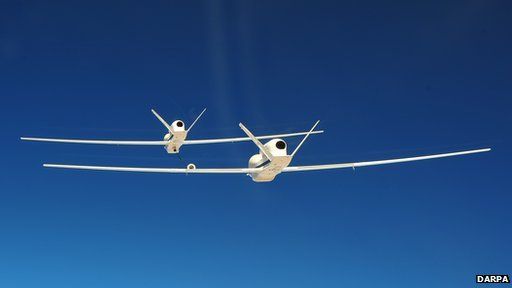Unstaffed drone refuelling test 'successful'
- Published

Two unmanned drones were able to fly close enough together for an automated refuel to take place, in tests carried out by the Defense Advanced Research Projects Agency (Darpa).
The two planes flew closely at an altitude of 48,000ft (14,630m) for "the majority" of a 2.5 hour flight, the US agency said.
The fuel probe could only be 100ft (30m) at most from the fuel receiver.
During earlier tests this had only been possible with a pilot on board.
"The goal of this demonstration was to create the expectation that future Hale [High Altitude Long Endurance] aircraft will be refuelled in flight," said Jim McCormick, from Darpa.
"Such designs should be more affordable to own and operate across a range of mission profiles than systems built to satisfy the most stressing case without refuelling."
The drones used in the experimental flights were modified RQ-4 Global Hawk planes, which are generally used for surveillance.
The result is the culmination of a two-year research project called the Autonomous High Altitude Refuelling (AHR) programme.
The team said the conclusion of the project was better than expected.
"Since Hale aircraft are designed for endurance at the expense of control authority, the programme started with the expectation that only one of six attempts would achieve positive contact (17%). The final analysis, however, indicated that 60% of the attempts would achieve contact," said a statement on the Darpa website.
"The lessons from AHR certainly extend beyond the Hale flight regime, and insights into non-traditional tanker concepts may offer further operational advantages," said Mr McCormick.
- Published7 October 2012
- Published6 October 2012